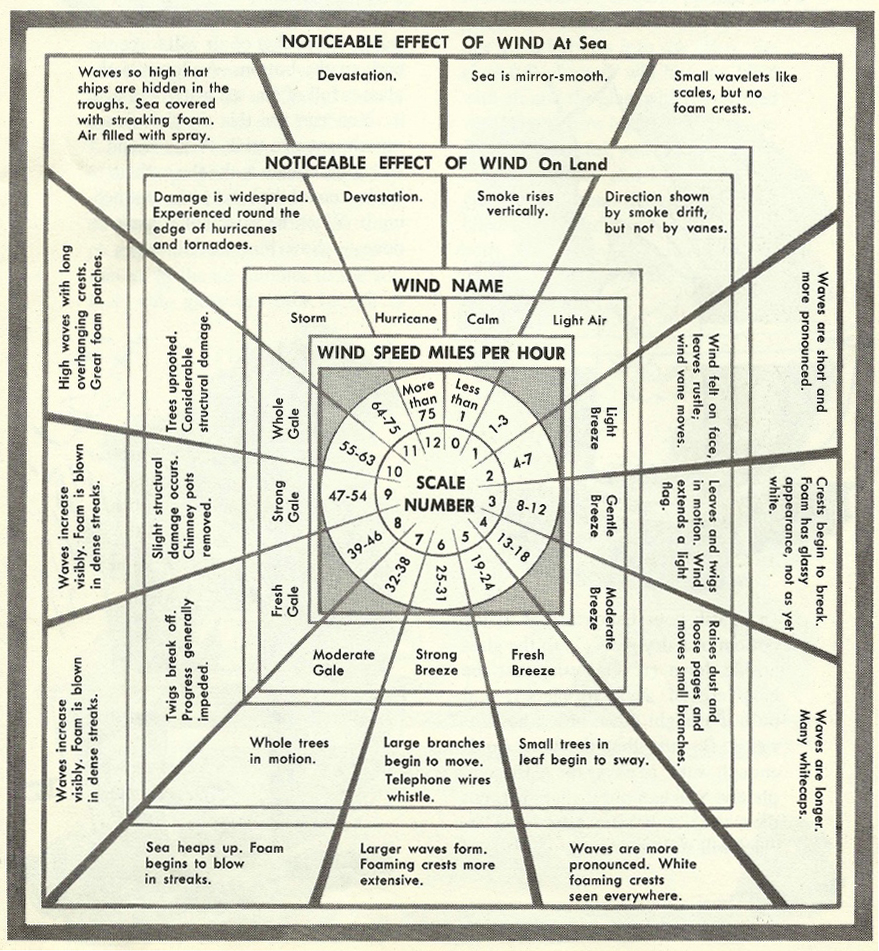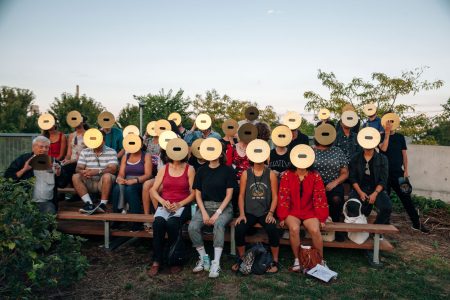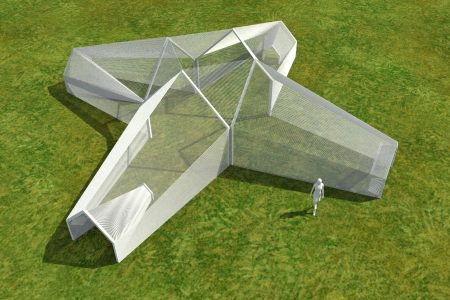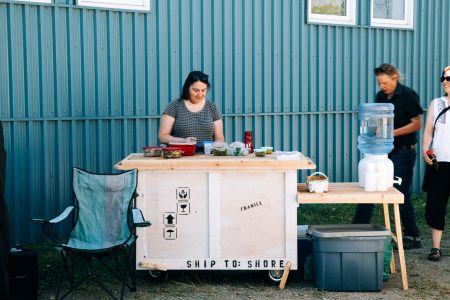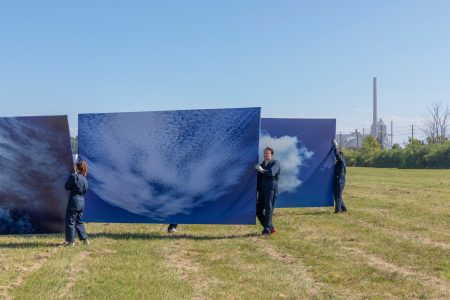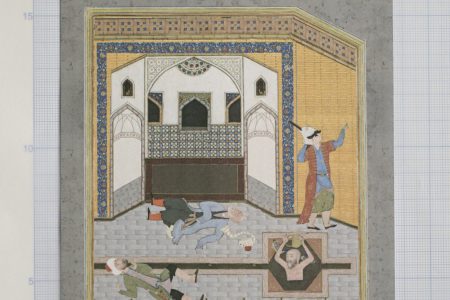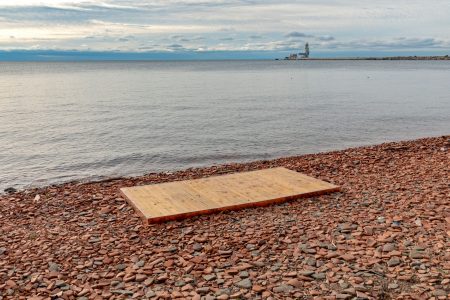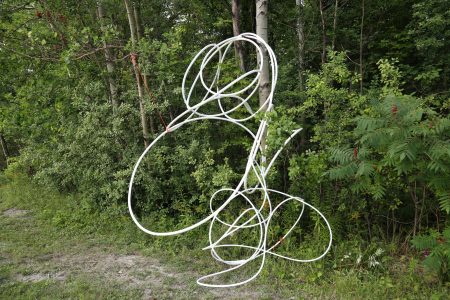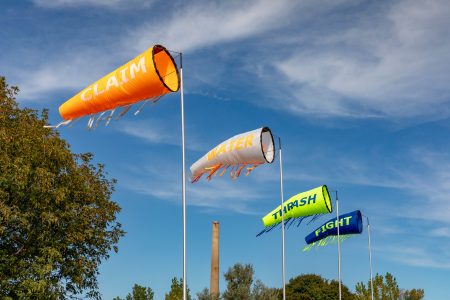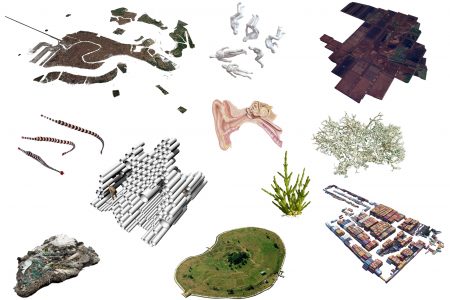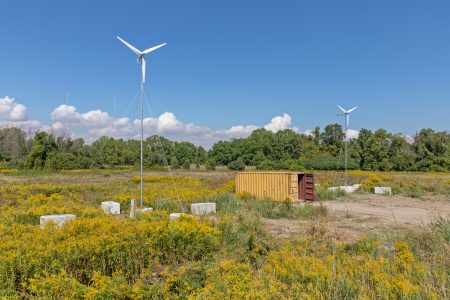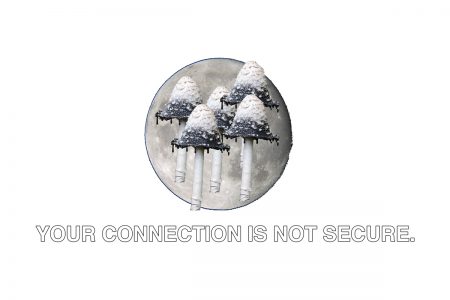extreme weather events, energy battlefields, extraction zones, carbon reserves, volatile oceanic experiences, radioactive clouds, plastic pollution, brownfields, water toxicity, landfill leachate, floods, tsunamis, uprooted trees, ocean acidification, marginal ice zones, atmospheres of contemporary algorithms, deviant predictions, supply chain labor, real estate booms, uneven development, deforestation, species extinction, detritus of a derelict economy, destroyed houses, sinking and melting, climate refuge, submerged perspectives, plant stories, water cannons and tear gas, wind gusts and storms, sounds of sand, mosquito clouds, fugitive dust, post-natural ecologies…
A picture emerges.
We live in a time of accelerated global warming, environmental degradation, and radical transformations in the Earth’s ecosystems to the extent that life for future generations is becoming increasingly difficult. Despite our insight into the destructive effects of human impact on the Earth, we seem unable to act in accordance with this knowledge. One reason has to do with the abstract quality of scientific data, which tends to make it impalpable. Another has to do with the temporal character of the data; it seems that since the damage has already occurred it is too late to act. In addition to this, the perspectives of climate change are overwhelming in their demand for a radical transformation of the way we think, live, act, and breathe. Confronted with ecosystem collapse we seem to be at an impasse between the impossible and the inevitable. Rather than demand political action and change our everyday praxis, we often experience a sense of powerlessness in relation to it. The totality of disaster overwhelms us to such a degree that pacification results, which suggests that instead we need to change our perspective, detect the openings in this seeming impasse, and generate possibilities for collective action and strategic engagement.
read moreThe first step is to acknowledge that climate change, as Kyle Powys Whyte of the Potawatomi Nation argues, is an “unprecedentedly old crisis” [1], a crisis that Heather Davis and Zoe Todd observe is “the cyclical recurrence of logics of extraction (of bodies, lands, minerals, fossil fuels) that have amplified to become a global phenomenon.” [2]. The second step is to recognize that the Earth is not an infinitely replenishable resource. In order to recognize these facts and act to mitigate their most disastrous effects, a renewed culture of learning is urgently necessary. Stimulated by the narrative potency of contemporary art practices and bolstered by its unique position as a university art gallery, the Blackwood Gallery presents The Work of Wind: Air, Land, Sea and asks: How are we affected by this cancellation of the future? Can artists facilitate observation of human impact on the Earth and make observation a truly public enterprise? How can observation lead to action?
The Work of Wind: Air, Land, Sea is a site-specific exhibition, public program series, and publication platform designed to expand perspectives on climate change through artistic practices, cultural inquiry, and political mobilization. To do so, the project appropriates the Beaufort Scale of Wind Force as an organizing device.
Beaufort Scale of Wind Force
In 1806, the British hydrographer and sea admiral Sir Francis Beaufort invented the Beaufort Scale of Wind Force, an index of thirteen levels measuring wind force first used for the practical navigation of 19th century ocean space. It takes the wind at sea, anywhere all over the planet—wherever a ship might encounter it—and reduces it to a format that is not only clear but quantifiable and communicable. The Beaufort Scale takes observation and turns it into information. Beaufort offered sailors something by which they could gauge the force of wind, they could measure it by the ship itself. All they had to do was look around them. By taking a list of words (for example, CALM, MODERATE BREEZE, VIOLENT STORM) and, by attaching them to something real, something actual and observable —“waves are formed,” “leaves are blown from trees,” “houses are destroyed”—Beaufort had suddenly made them meaningful, useful, a self-evident scale that every sailor on a frigate or man-of-war could be expected to easily apply. The Beaufort Scale of Wind Force became a method for seeing and understanding one’s surroundings, but it also became a tool to expedite colonial processes of extraction, accumulation, privatization, and land dispossession.
Artists in the 21st century can gauge the current conditions of the Earth by looking around them and turning their observations into modulators of attention, inciting us to apply strategies and tactics to get us from the here of our current ecological-economic dead-end to a there that is ecologically sustainable with humans in it. In 2018/19, The Work of Wind: Air, Land, Sea turns the Beaufort Scale of Wind Force into a diagram of prediction and premonition in the context of accelerating planetary extinction. While the title might suggest a weather project, it is not about wind but of wind, of the forces of composition and decomposition predicated on the complex entanglements of ecologies of excess, environmental legacies of colonialism, the financialization of weather, contemporary catastrophism, politics of sustainability, climate justice, and resilience.
Southdown Industrial Area
This project transforms the Southdown Industrial Area in Mississauga into a site-specific contemporary art exhibition with commissioned works by Canadian and international artists. Bordered by Clarkson to the north and Lake Ontario to the south, this complex 1.5km2 area features an oil and lubricants refinery, a carbon dioxide production facility, a nursery, heritage sites, brownfields, commercial transport hubs, a wastewater treatment plant, a cement plant, a gypsum pier, a rail line, a hazardous waste management facility, fields of phragmites, a fruit distribution centre, an abandoned paint and resin plant, a working hay farm, a radio transmission field, among others. These are in addition to the popular recreational sites of the Petro Canada Park and Cricket Ground and Lakeside Park, with its Cobble Beach comprised of the remnants of buried clay pipes from the National Sewer Pipe Company, increasingly exposed as the shoreline and bank erodes.
The Work of Wind: Air, Land, Sea
Drawing on the language of the Beaufort Scale of Wind Force—breaking, scattering, drifting, tumbling, rolling, driving, whistling, rustling, extending, raising, swaying, inconveniencing, impeding, damaging, uprooting—the exhibition unfurls the 13 Beaufort forces, from 0 (Calm) to 12 (Hurricane) across the area with 13 site-specific artist projects moving between modes of allegory and creative adaptation strategies.
From Secwpemc artist Tania Willard’s The Liberation of the Chinook Wind that turns wind speed data passing through four windsocks into poetry, to Jana Winderen’s four-channel sound installation based on recordings of creatures from the planet’s most vulnerable environments, to Julian Oliver’s installation of wind turbines that mine cryptocurrency to fund climate change research, to Ed Pien’s complex and intricately balanced water networks, many of the projects in the exhibition seek to materialize the human and non-human forces acting upon our environments. Installations such as Métis artist Dylan Miner’s platforms rematriating old-growth lumber harvested from the depths of Lake Ontario, Xiaojing Yan’s poetic meditation on the precarity of home, Pejvak (Rouzbeh Akhbari & Felix Kalmenson)’s exploration of ancient wind-catcher technology and tellurian toxification, and Gediminas & Nomeda Urbonas’s immersive Futurity Island which turns environmental data into sonic cries, address the structures—historical, metaphoric, and narrative—that govern our climate futures. Exploring the poetry and energy of the elemental, works by Paul Walde and Eduardo Navarro harness performance as a means of connecting to the atmospheric and the celestial, while Museo Aero Solar takes plastic bags out of Mississauga’s waste cycle to become a completely fossil-fuel free airborne sculpture, lifted only by the heat of the sun each day of the festival. Works by Lisa Myers and Christina Battle directly respond to the political urgency of climate action, working through histories of labour, sustenance, and environmental violence.
The Society for the Diffusion of Useful Knowledge
The Work of Wind: Air, Land, Sea is extended by a series of workshops, performances, publications, and discussions highlighting a year-long public program titled The Society for the Diffusion of Useful Knowledge (SDUK). The name of this innovative platform is borrowed from a non-profit society founded in London in 1826, focused on publishing inexpensive texts such as the widely read Penny Magazine and The Library of Useful Knowledge (of which Sir Francis Beaufort led the map and atlas section), and aimed at spreading important world knowledge to anyone seeking to self-educate. Continuing, and troubling, the origins of the society, the SDUK platform asks: what constitutes “useful knowledge”? For whom? And who decides? An ecology of knowledge based on the relationship and antagonism of “useful” ideas composed by The Society for the Diffusion of Useful Knowledge and circulated across the city of Mississauga through spring 2019.
We begin with more than 20 SDUK events organized in conjunction with The Work of Wind: Air, Land, Sea, and taking place in various locations within and between the artist commissions in the Southdown Industrial Area. The program of events includes performances on post-apocalyptic futures, remediation, and listening to the landscape; participatory workshops on atmospheric pollution, environmental monitoring, and aspiration; conversations on chemical contamination, Indigenous environmental justice, waste and plastic pollution, the Great Lakes, migrant rights, and food justice; a Useful Knowledge Hub bringing together University of Toronto Mississauga researchers, local environmental organizations, and City of Mississauga Divisions; plein air painting workshopsand lunchtime artist talks; and the launch of The Work of Wind: Land, the first book in a three-volume series co-published by K. Verlag and Blackwood Gallery.
The Work of Wind: Air, Land, Sea explores the complexity inherent in seeing and understanding climate change—for this reason, it takes form as a play between exhibition installations, public events, research, and the realities of the site where it takes place. It sees many kinds of knowledge about our world as fundamentally entangled. In doing so, it sets out to develop durable visual-cultural literacies, invites publics to create new encounters in the common struggle for a future, and points to a simple fact…
A new picture must emerge.
– Christine Shaw
